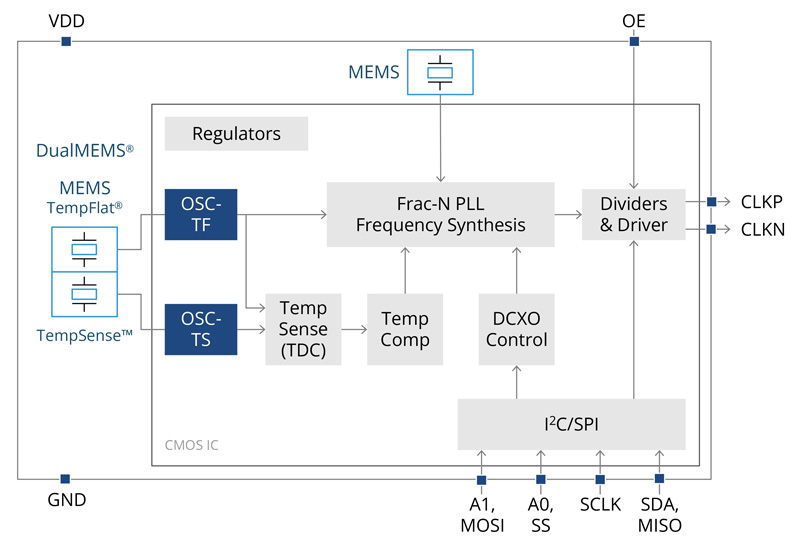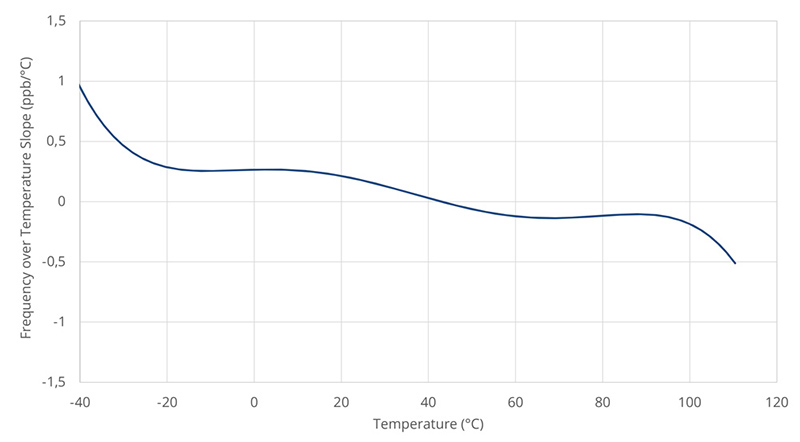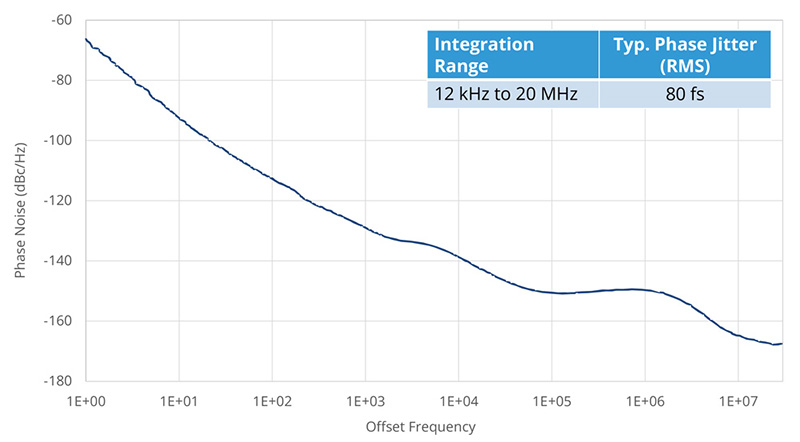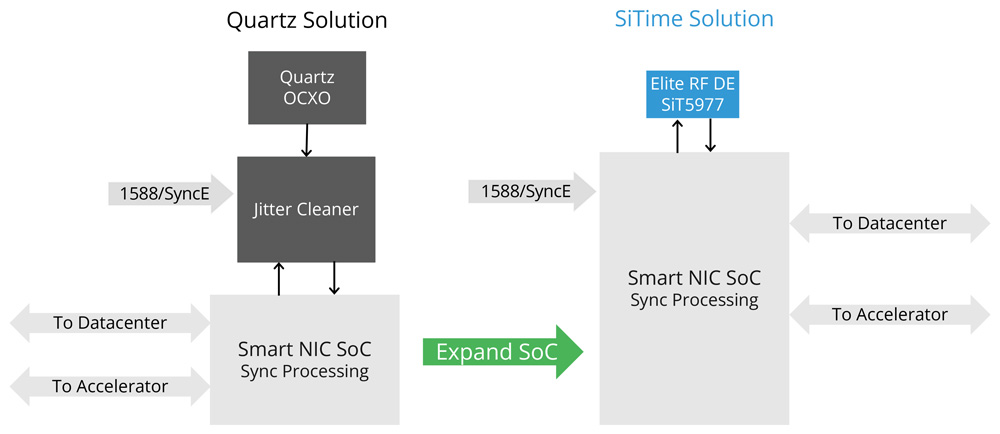Enabling Higher AI Workload Efficiency
The SiT5977 Super-TCXO is designed to streamline AI system architecture and optimize network efficiency. This reliable and resilient device provides better time synchronization for Smart NICs, acceleration cards, switches, compute node applications, and more.
- Environmentally robust with ±1 ppb/°C frequency slope (dF/dT) for optimum performance under airflow, thermal shock
-
Capable of driving 800G and higher links via 80 fs max phase jitter
-
Enables embedded control loops with frequency output tuning (DCTCXO) via I2C/SPI, ±400 ppm pull range & 0.05 ppt resolution
-
Eliminates link flaps caused by activity dips or micro jumps associated with quartz products
-
Mechanically robust with resistance to shock, vibration and board bending
-
Eliminates external LDOs with on-chip voltage regulators
-
Enables high-speed SerDes with 156.25 MHz output frequency
-
Superior noise immunity with LVDS differential output
-
Excellent frequency stability with ±100 ppb over temperature
Advanced All-Silicon Architecture

SiT5977 is the first TCXO to have a dedicated low phase noise MEMS resonator to drive the integrated PLL. This low-noise fractional PLL attenuates jitter from the DualMEMS® stability engine and delivers high frequency differential output with ultra low jitter. DualMEMS® combines a TempFlat® resonator with a TempSense™ resonator, and along with advanced temperature compensation, the SiT5977 delivers the best dynamic stability in the presence of airflow and rapid temperature change.
To support system level synchronization, this chip integrates digital control (DCTCXO) via an I2C/SPI interface to adjust the output frequency with a fine resolution. Additionally, multiple on-chip regulators filter power supply noise, eliminating the need for an external LDO (low-dropout) regulator.
3X Better Synchronization
As the adoption of AI continues at an extraordinary pace, datacenter utilization and workload efficiency are taking center stage. Large AI clusters can contain thousands of powerful servers equipped with tens of thousands of AI accelerators. AI workloads are supercharged by directly connecting compute nodes, and the accelerators within them, to distribute the tasks and increase productivity. As workloads are divided among the accelerators, SiT5977 is critical for synchronizing compute nodes and optimizing efficiency with 3X better synchronization compared to previous generation.
Interconnected Clusters Drive AI

Interconnected clusters are at the center of AI infrastructure, containing linked nodes and accelerators required to provide vast and efficient computational power.
Tighter time synchronization also facilitates more accurate telemetry, giving datacenter operators insight to eliminating underperforming compute nodes. In addition, highly tuned synchronization allows architects to reduce the guard band between data packets, known as the window of uncertainty. A smaller window of uncertainty reduces the risk of packets with overlapping time, in turn lowering the frequency of data re-transmits, therefore making the datacenter more efficient.
Best Dynamic Stability

SiT5977 offers the best-in-class dynamic stability with ±1 ppb/°C frequency over temperature slope (dF/dT).
The ability to maintain tight synchronization in harsh datacenter environments is essential. However, heat generated by powerful AI processing units combined with cooling fans can create rapid and extreme temperature transients that affect quartz devices, leading to dropped packets and poor synchronization. This is no problem for the SiT5977 Super-TCXO which is resistant to environmental stressors. SiT5977 operates at ±1 ppb/°C frequency over temperature slope (dF/dT) to ensure stability under airflow and thermal shock. This means no performance throttling, smaller windows of uncertainty, and fewer workload restarts, which can cost datacenter operators hundreds of thousands of dollars.
800G Network Connectivity
Equally important to synchronization is fully utilized, high-speed network bandwidth. 800G is becoming essential to support the intensive bandwidth and low latency needs of AI workloads. To support high-speed connectivity, SiT5977 integrates a low-noise PLL, which produces a clean clock edge and exceptionally low jitter, lowering bit error rates. SiT5977 is the first TCXO to offer high-speed differential output for high-speed data communication.
Ultra-Low Phase Jitter

SiT5977 offers ultra-low phase jitter at 80 fs from 12kHz to 20MHz to support 800G data.
Low jitter performance is vital to enabling higher bandwidths in next-generation AI datacenters, reducing accelerator idling time while they wait for data. The class-leading jitter performance of SiT5977 removes data bottlenecks and ensures that accelerators run as efficiently as possible. Together, precision synchronization and higher bandwidth utilization increase the productivity of the entire datacenter.
4X Smaller Footprint
By integrating ultra-low phase jitter and high-resolution digital frequency control into a 5.0 mm x 3.5 mm package (compatible with a 5.0 mm x 3.2 mm footprint), the jitter cleaner typically used in the traditional quartz-based timing architecture can be removed. By eliminating the jitter cleaner and using a small TCXO as opposed to a larger OCXO, the timing footprint is made 4x smaller. This allows for the use of larger processors in space-constrained systems, enabling system architects to fully leverage the high-speed 800G bandwidth.
New Architectural Options for Faster Processing

In a Smart NIC application, the small SiT5977 Super-TCXO with its ultra-low jitter and digital output frequency control can eliminate the need for a jitter cleaner. This affords additional real estate for a more powerful processor and enables new architectural options.
Key Resources
SiT5977 Differential Ended Super-TCXO FAQs

New Architecture for Greater AI Workload Efficiency in Datacenters

Precision Timing for More Efficient AI Datacenters

